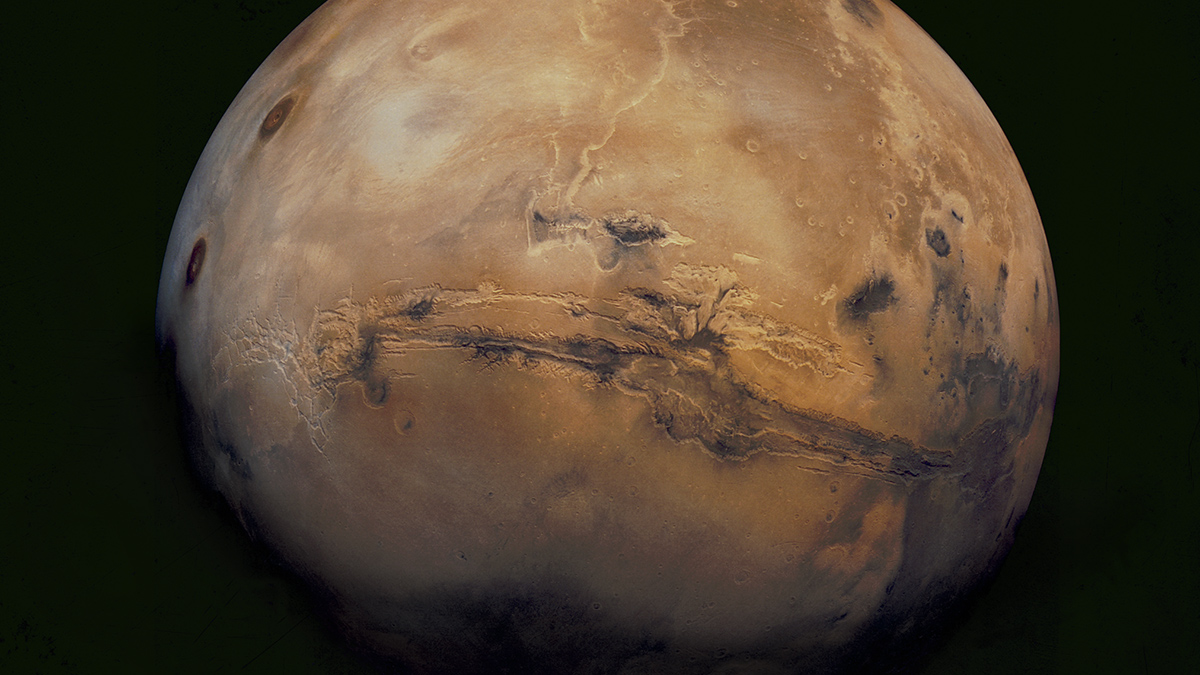A large and ancient volcano may be hiding in heavily fractured and eroded terrain on Mars, between the planet’s largest canyons and its biggest volcanoes, according to recent research. Tentatively named Noctis Mons, it could have roared to life early in Martian history and continued to erupt as recently as tens of millions of years ago.
Pascal Lee, a planetary scientist at the SETI Institute and the Mars Institute at NASA’s Ames Research Center, and Sourabh Shubham, a graduate student at the University of Maryland, discovered the possible volcano while studying a relict glacier in Noctis Labyrinthus (Labyrinth of Night), a region just north of the equator.
“We kept zooming out, and we couldn’t believe when we saw that the entire eastern part of Noctis Labyrinthus could be interpreted as a deeply eroded, large volcano,” Lee said.
The pair reported their findings at the Lunar and Planetary Science Conference in March.
“It’s quite amazing that this feature has been hiding in plain view for so long.”
The region’s topography, possible calderas at the summit, volcanic terrain around the summit, and minerals that likely had a volcanic origin gave the volcano away, according to the researchers. The location—between the giant Tharsis volcanoes to the west and Valles Marineris, a canyon complex that would stretch from San Francisco to Washington, D.C., to the east—was also a clue.
“I think the evidence that this structure is a volcano is quite clear: The central caldera-like depression and gradual slopes leading up to it are pretty definitive,” said Jeff Andrews-Hanna, a planetary scientist at the University of Arizona who was not involved in the research. “In retrospect, it’s quite amazing that this feature has been hiding in plain view for so long.”
Blistered Terrain Suggests Volcanic Origin
Lee began studying Noctis Labyrinthus in detail when he proposed a mesa in the region as a possible landing site for a human mission to Mars. “From this location you could go east into the canyons, which might hold evidence of past life, or west into the Tharsis plateau, which has caves and lava tubes where you could look for modern life,” Lee said. He and colleagues had previously discovered a relict (and possibly still existing) glacier at Noctis Labyrinthus, visible through collapsed areas in the overlying crust.
As Lee and Shubham studied images from several Mars-orbiting spacecraft, they found that the glacial feature lies within a 5,000-square-kilometer field of volcanic terrain, much of which is covered with “blisters.” The blisters look like the “rootless cones” found on Earth that form when volcanic material is deposited atop water or ice, creating steam that blasts through the overlying material.

Shubham studied surface deposits in the region, which include hydrated minerals, especially jarosite, a sulfur-rich mineral that can form when acidic volcanic materials interact with water. He also found evidence of pyroxene, which can form when pyroclastic materials—ash, pumice, and other explosive debris—react with glacial ice. The combination suggests recent volcanic activity in the region. And the layer of volcanic debris could function as an insulating blanket, potentially preserving glacial ice on geological timescales, Lee said.
The researchers also used laser altimeter data to map surface elevations and found a cone-shaped structure topping out at greater than 9,000 meters. The surrounding terrain gently slopes away in every direction, with an outer perimeter up to 225 kilometers from the summit. Two circular features at the center of the structure could be remnant calderas.
“We don’t see any alternative explanation.”
The region has been heavily eroded, forming a jumble of canyons and mesas that make it difficult to see the mountain’s shape.
“At this point, we’re convinced that all the morphological features are consistent with a volcano, and so is all the mineralogy evidence,” Shubham said. “We don’t see any alternative explanation.”
“There could be some volcanic features there, but I’m not sure if the whole thing is volcanic—I’m not sure that’s the right conclusion,” said Patrick Whelley, a planetary geologist at the University of Maryland and Goddard Space Flight Center who was not involved in the study. “But in big-picture Martian geology it would make sense to have a volcano there. It wouldn’t be a huge paradigm shift.”
Last Eruptions Could Have Been Recent
Noctis Mons could have formed as a shield volcano during the Noachian period, perhaps 3.8 billion years ago, Lee said. Over the eons, the mountain would have grown as it accumulated layers of lava, pyroclastic materials, and ice. Upwelling magma may have then elevated the region, creating fractures and faults in the surface. Erupting lava might have destroyed large amounts of ice, causing parts of Noctis Mons to collapse. Later glaciation would have carved the present-day canyons.
The volcano could have been active in the relatively recent past, Lee said—“maybe just tens of millions of years ago”—and it’s possible that it could be dormant today but not extinct. Impact crater counts should help refine that estimate: Fewer craters would indicate a younger surface.
Noctis Mons should make the proposed landing site even more appealing, Lee said. “It’s a place with water and sustained heat, which are really important for astrobiology — it’s a place where we might want to look for signs of life, past or present,” he said.
The discovery also raises the possibility that other major features remain hidden in plain sight on the Red Planet, Andrews-Hanna said. “This just goes to show that even after more than half a century of exploration, Mars still has some surprises to offer us.”
—Damond Benningfield, Science Writer
Citation: Benningfield, D. (2024), Martian jumble may be hiding a giant volcano, Eos, 105, https://doi.org/10.1029/2024EO240180. Published on 19 April 2024.
Text © 2024. The authors. CC BY-NC-ND 3.0
Except where otherwise noted, images are subject to copyright. Any reuse without express permission from the copyright owner is prohibited.
Related

Shambhu Kumar is a science communicator, making complex scientific topics accessible to all. His articles explore breakthroughs in various scientific disciplines, from space exploration to cutting-edge research.


